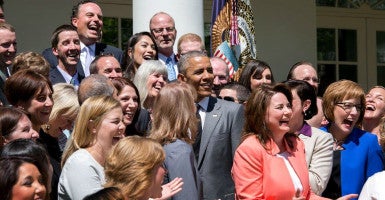From the administration that brought you Common Core national standards and tests comes the news that the White House and Department of Education now are worried about too much testing in schools.
Take the Obama administration’s concerns with a grain of salt, however: The new recommendations to cap assessments are unlikely to reduce any perceived testing burden. They likely would mean more federal direction of what takes place inside school classrooms.
Over the weekend, President Obama called for a reduction in testing in public schools, saying he would work “aggressively” with states and local school districts on the effort.
Education Secretary Arne Duncan’s fact sheet states that tests should be worth taking, of high quality, and fair. Notably, this new testing plan recommends that no more than 2 percent of classroom time should be used for testing:
While it is up to states and districts how to balance instructional time and the need for high-quality assessments, we recommend that states place a cap on the percentage of instructional time students spend taking required statewide standardized assessments to ensure that no child spends more than 2 percent of her classroom time taking these tests. Parents should receive formal notification if their child’s school exceeds this cap and an action plan should be publicly posted to describe the steps the state will take to review and eliminate unnecessary assessments, and come into compliance.
Although the administration purports to want to cap testing, Duncan also stressed the importance of annual testing. This likely means the administration supports maintaining the annual testing requirement in the No Child Left Behind law, which dictates that children take standardized tests annually in grades 3 through 8 and once again in high school.
Those annual testing requirements, in conjunction with state and local tests often conducted to predict how students will perform on NCLB-mandated tests, mean students in large cities take an average of 112 mandated, standardized tests from pre-kindergarten through graduation, according to the Council of the Great City Schools. Unless Congress makes changes to No Child Left Behind that address the law’s annual testing requirement, those frequent annual assessments, which average eight per year for students, will remain.
The new proposal from Obama and Duncan also calls for an end to so-called “double testing,” which disproportionately affects 8th-grade students. Students who take advanced high-school level coursework in 8th grade currently also must take the same statewide math and reading tests as all students, according to NCLB’s guidelines.
This results in double testing for some students. The Obama administration would offer a waiver from the requirement.
But the most consequential–and potentially controversial–aspect of the administration’s plan is to recommend schools cap at 2 percent the amount of classroom instruction time spent on tests.. Regardless of one’s position on the merits of standardized testing, a federal recommendation on how much time can be spent on tests would certainly drive classroom-level decision-making.
The proposal raises a host of unanswered questions and unintended consequences: What tests would be included as part of the cap? Who would enforce and monitor it? How would it affect schools that use frequent formative assessments to gauge student progress?
And what about parents who have chosen a particular school, perhaps an online charter school, because they like an emphasis on testing?
Unanswered questions and unintended consequences aside, the proposed 2 percent cap isn’t even a substantial reduction. As already mentioned, mandated standardized tests tend to fall most heavily on 8th-grade students, typically constituting about 2.3 percent of school time.
So at their estimated height, testing as a percentage of school time reaches 2.3 percent, which the administration wants to cap at 2 percent. That percentage represents testing time itself, not test preparation, further weakening any potential impact of the reduction.
Regardless of views on testing, the federal government of all places should not be establishing recommendations for limits on the proportion of school time tests can constitute. A 2 percent cap on testing could end up being equally as arbitrary and intrusive as the testing requirements in No Child Left Behind.
Instead of adding new and more complicated waivers–on top of existing waivers used by the administration to create policy from the executive branch–the federal government needs to stop dictating testing schedules generally.
Tests are important when used as the type of diagnostic tools valued by that parents. But the federal government is a blunt instrument for setting testing schedules at the school level. By comparison, the National Assessment of Educational Progress long has served as a good external audit of state performance. It is adequate for informing federal policymakers about state performance.
The Obama administration isn’t proposing to limit Washington’s involvement in testing in any meaningful way. If anything, it appears they’re making a federal testing mess even messier.
Intelligent people can have a meaningful discussion over the role of testing in education. However, a sweeping declaration from the federal government does nothing to settle this debate. Indeed, it further pushes all children into one category instead of bolstering policy that addresses each child’s unique needs.
Washington should extricate itself from setting school testing schedules, and state and local policymakers should advance school-choice options. Choice in education calls upon parents’ unique understanding of their child’s learning needs, and is the best way to address the issue of how much testing is the right amount.
President Obama’s call for less testing ignores the lessons learned from No Child Left Behind. Federal intervention in education discounts learning differences among students, instead of celebrating them. The consequences of large, burdensome government programs can’t be solved with more regulations on the classroom.
American families need more options, not more mandates.






























